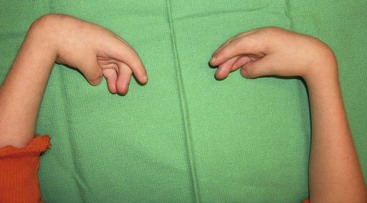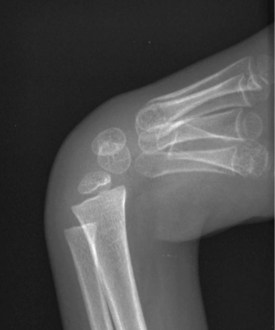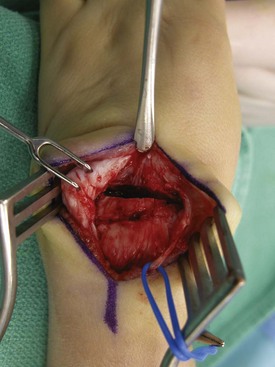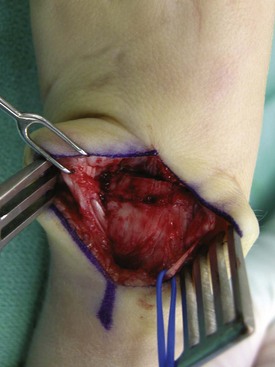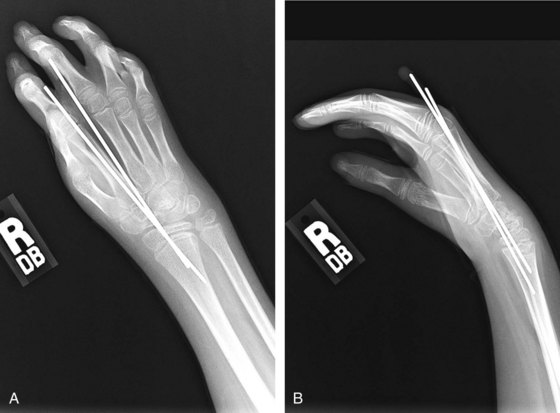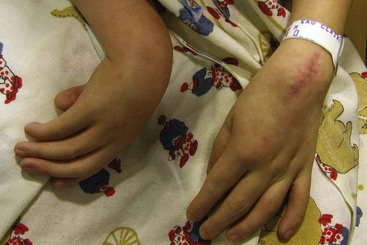Procedure 43 Carpal Wedge Osteotomy for Congenital Wrist Flexion Contracture (Arthrogryposis)
![]() See Video 35: Triceps Lengthening and Elbow Release in Arthrogryposis
See Video 35: Triceps Lengthening and Elbow Release in Arthrogryposis
Examination/Imaging
Clinical Examination
 The ability of the child to open and close the fingers should be determined. If the child does not have active finger extension, correction of the wrist flexion contracture will result in loss of ability to passively extend the finger by the tenodesis effect (Fig. 43-3).
The ability of the child to open and close the fingers should be determined. If the child does not have active finger extension, correction of the wrist flexion contracture will result in loss of ability to passively extend the finger by the tenodesis effect (Fig. 43-3).
 The function of the extensor carpi ulnaris (ECU) should be assessed. A transfer of the ECU to the radial wrist extensors may be required to improve wrist extension and diminish the ulnar deviation deformity.
The function of the extensor carpi ulnaris (ECU) should be assessed. A transfer of the ECU to the radial wrist extensors may be required to improve wrist extension and diminish the ulnar deviation deformity.
 It is important to examine the child along with an occupational therapist to evaluate the functional status of the wrist. This will help to determine the optimal wrist position in children who need surgery and to avoid surgery in children who have adapted well to the wrist flexion contracture.
It is important to examine the child along with an occupational therapist to evaluate the functional status of the wrist. This will help to determine the optimal wrist position in children who need surgery and to avoid surgery in children who have adapted well to the wrist flexion contracture.
 These children frequently have lower limb anomalies that can be corrected simultaneously to reduce the overall number of procedures.
These children frequently have lower limb anomalies that can be corrected simultaneously to reduce the overall number of procedures.
Positioning
 The procedure is performed under tourniquet control with the patient in the supine position. The degree of elbow contracture may complicate arm position during surgery. The tourniquet should be placed as high as possible to increase the surgical field.
The procedure is performed under tourniquet control with the patient in the supine position. The degree of elbow contracture may complicate arm position during surgery. The tourniquet should be placed as high as possible to increase the surgical field.
 Intraoperative fluoroscopy will be required to plan the wedge resection and to confirm position of the K-wires that will be used for fixation.
Intraoperative fluoroscopy will be required to plan the wedge resection and to confirm position of the K-wires that will be used for fixation.
Exposures
 A single 4-cm longitudinal incision centered over the dorsum of the wrist is made. The extensor retinaculum is identified, and skin flaps are raised on both sides superficial to the retinaculum.
A single 4-cm longitudinal incision centered over the dorsum of the wrist is made. The extensor retinaculum is identified, and skin flaps are raised on both sides superficial to the retinaculum.
 The third compartment is identified by its location ulnar to Lister tubercle and opened. The extensor pollicis longus (EPL) tendon is brought out of the third compartment.
The third compartment is identified by its location ulnar to Lister tubercle and opened. The extensor pollicis longus (EPL) tendon is brought out of the third compartment.
 The wrist capsule is opened in the floor of the third compartment. The second and fourth compartments are elevated extraperiosteally off the distal radius and the carpus to expose the carpus.
The wrist capsule is opened in the floor of the third compartment. The second and fourth compartments are elevated extraperiosteally off the distal radius and the carpus to expose the carpus.
Procedure
Step 1
 A wedge of bone is removed from the midcarpal joint using an osteotomy. The amount of bone removed depends on the preoperative flexion and ulnar deviation deformity. The proximal cut is made perpendicular to the long axis of the radius, and the distal cut is made perpendicular to the metacarpals. This results in a wedge because of the flexion deformity. The wedge should be made wider on the radial side if correction of an ulnar deviation deformity is also required (Fig. 43-4).
A wedge of bone is removed from the midcarpal joint using an osteotomy. The amount of bone removed depends on the preoperative flexion and ulnar deviation deformity. The proximal cut is made perpendicular to the long axis of the radius, and the distal cut is made perpendicular to the metacarpals. This results in a wedge because of the flexion deformity. The wedge should be made wider on the radial side if correction of an ulnar deviation deformity is also required (Fig. 43-4).
Step 1 Pearls
Intraoperative fluoroscopy can be used to confirm the position of the osteotomy in the older child. In the younger child whose carpus has not yet ossified, the position should be confirmed visually.
A scalpel blade can be used in the younger child because the carpus is relatively soft. An osteotome will be required in the older child. Using a saw is not necessary because there is less control of the cut and the bone is soft.
Step 2
 The aim of the wedge osteotomy is to get the wrist into a posture of slight extension (Fig. 43-5). If the wrist cannot be brought into this position, tendons on the volar side need to be released. A 4-cm volar longitudinal incision is made proximal to the wrist crease and ulnar to the palmaris longus.
The aim of the wedge osteotomy is to get the wrist into a posture of slight extension (Fig. 43-5). If the wrist cannot be brought into this position, tendons on the volar side need to be released. A 4-cm volar longitudinal incision is made proximal to the wrist crease and ulnar to the palmaris longus.
 A tight palmaris longus tendon can be divided. Up to 2 cm of lengthening can be obtained by dividing the tendinous portions at the musculotendinous junction.
A tight palmaris longus tendon can be divided. Up to 2 cm of lengthening can be obtained by dividing the tendinous portions at the musculotendinous junction.
Postoperative Care and Expected Outcomes
 The limb is immobilized in an above-elbow fiberglass cast. The cast will be maintained for 6 weeks to allow the osteotomy site to heal. The K-wires are removed at 6 weeks, and the osteotomy site is protected with use of an intermittent splint for 3 months. Finger motion is permitted within the cast.
The limb is immobilized in an above-elbow fiberglass cast. The cast will be maintained for 6 weeks to allow the osteotomy site to heal. The K-wires are removed at 6 weeks, and the osteotomy site is protected with use of an intermittent splint for 3 months. Finger motion is permitted within the cast.
 Formal therapy is usually not required in younger children who adjust to the repositioned wrist. Surgery reliably repositions the wrist, which improves grasp (Fig. 43-7). Improvements in activities of daily living are dependent on degree of limb involvement and overall status of the child.
Formal therapy is usually not required in younger children who adjust to the repositioned wrist. Surgery reliably repositions the wrist, which improves grasp (Fig. 43-7). Improvements in activities of daily living are dependent on degree of limb involvement and overall status of the child.


